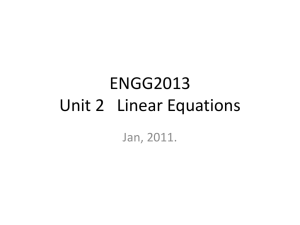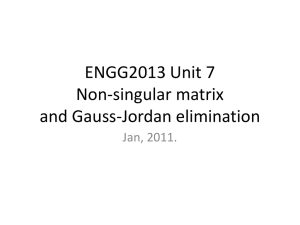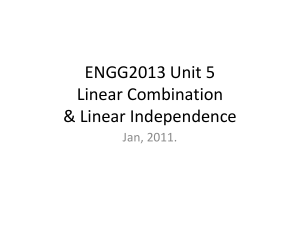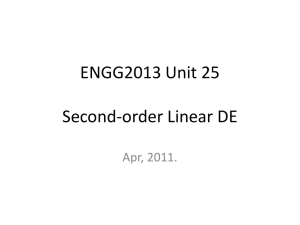Rank, determinant, dimension, and their links
advertisement
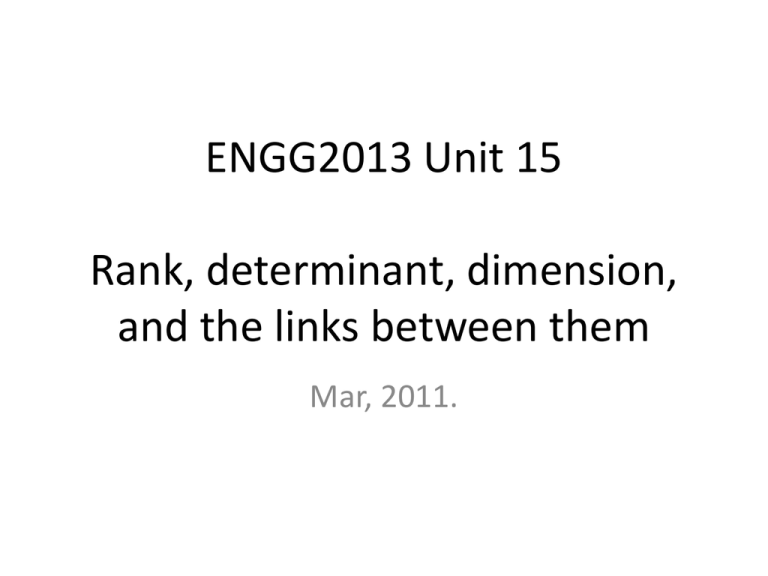
ENGG2013 Unit 15 Rank, determinant, dimension, and the links between them Mar, 2011. Review on “rank” • “row-rank of a matrix” counts the max. number of linearly independent rows. • “column-rank of a matrix” counts the max. number of linearly independent columns. • One application: Given a large system of linear equations, count the number of essentially different equations. – The number of essentially different equations is just the row-rank of the augmented matrix. kshum ENGG2013 2 Evaluating the row-rank by definition Linearly independent Linearly independent Linearly independent Linearly dependent Linearly independent Linearly independent Row-Rank = 2 Linearly dependent kshum ENGG2013 3 Calculation of row-rank via RREF Row reductions Row-rank = 2 Row-rank = 2 Because row reductions do not affect the number of linearly independent rows kshum ENGG2013 4 Calculation of column-rank by definition List all combinations of columns Column-Rank = 2 Linearly independent?? Y Y N Y N Y Y N Y Y Y Y Y N N kshum ENGG2013 5 Theorem Given any matrix, its row-rank and column-rank are equal. In view of this property, we can just say the “rank of a matrix”. It means either the row-rank of column-rank. kshum ENGG2013 6 Why row-rank = column-rank? • If some column vectors are linearly dependent, they remain linearly dependent after any elementary row operation • For example, are linearly dependent kshum ENGG2013 7 Why row-rank = column-rank? • Any row operation does not change the column- rank. • By the same argument, apply to the transpose of the matrix, we conclude that any column operation does not change the row-rank as well. kshum ENGG2013 8 Why row-rank = column-rank? Apply row reductions. row-rank and column-rank do not change. Apply column reductions. row-rank and column-rank do not change. The top-left corner is an identity matrix. The row-rank and column-rank of this “normal form” is certainly the size of this identity submatrix, and are therefore equal. kshum ENGG2013 9 DISCRIMINANT, DETERMINANT AND RANK kshum ENGG2013 10 Discriminant of a quadratic equation • y = ax2+bx+c • Discirminant of ax2+bx+c = b2-4ac. • It determines whether the roots are distinct or not y x kshum ENGG2013 11 Discriminant measures the separation of roots • y = x2+bx+c. Let the roots be and . • y = (x – )(x – ). Discriminant = ( – )2. • Discriminant is zero means that the two roots coincide. y ( – )2 x kshum ENGG2013 12 Discriminant is invariant under translation • If we substitute u= x – t into y = ax2+bx+c, (t is any real constant), then the discriminant of a(u+t)2+b(u+t)+c, as a polynomial in u, is the same as before. y ( – )2 u kshum ENGG2013 13 Determinant of a square matrix • The determinant of a square matrix determine whether the matrix is invertible or not. – Zero determinant: not invertible – Non-zero determinant: invertible. kshum ENGG2013 14 Determinant measure the area • 22 determinant measures the area of a parallelogram. • 33 determinant measures the volume of a parallelopiped. • nn determinant measures the “volume” of some “parallelogram” in n-dimension. • Determinant is zero means that the columns vectors lie in some lower-dimensional space. kshum ENGG2013 15 Determinant is invariant under shearing action • Shearing action = third kind of elementary row or column operation kshum ENGG2013 16 Rank of a rectangular matrix • The rank of a matrix counts the maximal number of linearly independent rows. • It also counts the maximal number of linearly independent columns. • It is an integer. • If the matrix is mn, then the rank is an integer between 0 and min(m,n). kshum ENGG2013 17 Rank is invariant under row and column operations Rank = 2 Rank = 2 Rank = 2 Rank = 2 Rank = 2 kshum Rank = 2 Rank = 2 ENGG2013 18 Comparison between det and rank Determinant • Real number • Defined to square matrix only • Non-zero det implies existence of inverse. • When det is zero, we only know that all the columns (or rows) together are linearly dependent, but don’t know any information about subset of columns (or rows) which are linearly independent. kshum Rank • Integer • Defined to any rectangular matrix • When applied to nn square matrix, rank=n implies existence of inverse. ENGG2013 19 Basis: Definition • For any given vector in if there is one and only one choice for the coefficients c1, c2, …,ck, such that we say that these k vectors form a basis of kshum ENGG2013 . 20 Yet another interpretation of rank • Recall that a subspace W in which is is a subset – Closed under addition: Sum of any two vectors in W stay in W. – Closed under scalar multiplication: scalar multiple of any vector in W stays in W as well. W kshum ENGG2013 21 Closedness property of subspace W kshum ENGG2013 22 Geometric picture x – 3y + z = 0 W z y x W is the plane generated, or spanned, by these vectors. kshum ENGG2013 23 Basis and dimension • A basis of a subspace W is a set of linearly independent vectors which span W. • A rigorous definition of the dimension is: z y W Dim(W) = the number of vectors in a basis of W. x kshum ENGG2013 24 Rank as dimension • In this context, the rank of a matrix is the dimension of the subspace spanned by the rows of this matrix. – The least number of row vectors required to span the subspace spanned by the rows. • The rank is also the dimension of the subspace spanned by the column of this matrix. – The least number of column vectors required to span the subspace spanned by the columns kshum ENGG2013 25 Example x – 2y + z = 0 z y Rank = 2 The three row vectors lie on the same plane. Two of them is enough to describe the plane. kshum x ENGG2013 26 INTERPOLATION kshum ENGG2013 27 Polynomial interpolation • Given n points, find a polynomial of degree n-1 which goes through these n points. • Technical requirements: – All x-coordinates must be distinct – y-coordinates need not be distinct. y3 y2 y4 y1 x1 kshum x2 ENGG2013 x3 x4 28 Lagrange interpolation • Lagrange interpolating polynomial for four data points: kshum ENGG2013 29 Computing the coefficients by linear equations • We want to solve for coefficients c3, c2, c1, and c0, such that or equivalently kshum ENGG2013 30 The theoretical basis for polynomial interpolation • The determinant of a vandermonde matrix is non-zero, if all xi’s are distinct. Hence, we can always find the matrix inverse and solve the system of linear equations. kshum ENGG2013 31



